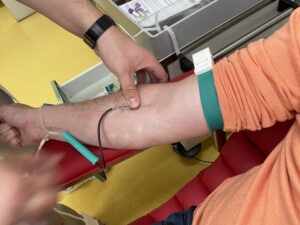If you’ve decided to plan the trip of a lifetime, you’ll know that while it’s hugely exciting, working out the best way to travel Europe can be a huge headache! At Euroventure, it is their passion and job to plan Europe trips for people all day every day. They know everyone’s number one problem is working out where to start – how do you work out what route to take? How will you get from city to city? Where should you stay? To help you out, they put together their most comprehensive planning guide, showing you exactly how to find the best way to travel Europe for you. If you’d like them to do the work for you, why not check out their set trips – these are their favorite routes around Europe. Or if you’d rather decide your own route, use their trip builder to plan your own custom route. Want some other people to travel with? Join a group tour and experience small group travel with one of our experienced Euroventure tour leaders.
What’s the best route to take?
The first step for any Europe trip is to work out a rough plan of where you’d like to go. While some people like to leave their schedule open while traveling, not planning your route at all could cost you serious time and money.
This is especially true in peak season when hostels and cheap train tickets can sell out months in advance.
Europe is deceptively big – and transport isn’t always straightforward; you can fill in the details later, but a bit of pre-planning will save you zigzagging all over the continent!
The most sensible way to do this is to write a list of your top destinations, alongside an idea of how long you’ve got in total. Next, get out a map and plot a route through your top destinations in geographical order – for example starting in Spain and working your way East, or beginning with Scandinavia and heading down to the Mediterranean. If you need some guidance with this, why not check out our trip builder tool? It allows you to map out your route, work out how long you’re going to spend traveling and how long you can spend in each city.
As a general rule, Europe gets cheaper the further East you go – bear this in mind if you’re planning a budget trip.
Pre-book it or wing it?
Deciding whether you want to pre-book your travel arrangements is a personal choice. Neither is a “better” way to travel Europe. Your choice will depend on your preference, and what you want to get out of traveling Europe. If you’re a confident traveler with lots of time and plenty of experience, you might prefer to see where your journey takes you. You can always ask hostel staff for tips on your next destination, and use free WiFi to book things as you go.
In our experience though, Europe is a popular starting point for first-time travelers. A lot of people aren’t comfortable with the idea of working their trip out on the move – if that’s you, don’t worry. There’s absolutely nothing wrong with sticking to a set itinerary when planning a Europe trip – it doesn’t have to be restrictive. On a practical note, pre-booking is now pretty much essential in some parts of Western Europe – we’re looking at you, Amsterdam! These days you’ll find accommodation and transport options start selling out weeks (or even months!) in advance.
Different people have different preferences for pre-booking
Some might feel the safest booking a group tour where everything is sorted in advance. That’s cool – tours are a great way to get the most out of Europe. Just make sure you pick a small group option where you’re really getting an authentic travel experience – check out our small-group tours here.
If you prefer a little bit more independence, why not book your accommodation and transport arrangements and leave your days free? Give yourself plenty of time in each city. Doing so means you can afford to be flexible with your days, without worrying about where you’ll lay your head at night. Take that spontaneous excursion, or head to the beach with some new hostel friends – and still have time to hit the main sights.
If that sounds like a good compromise, but planning your accommodation and travel seems overwhelming, why not take a look at some of our self-guided itineraries for inspiration?
What’s the best way to get around?
So you know roughly where you’re going, and how much you want to book upfront. The next stage is working out the best way to travel from place to place. Deciding which is the best way to get from A to B can be a major stress; there are pros and cons to each option. Everyone’s priorities are different, so they’ve given an overview of different transport choices in Europe, ranking each on convenience, cost, and time-saving so that you can compare the best option for yourself!
Option 1 – Flights
Cost
It’s well known that flights can be super cheap in Europe, with budget airlines like Easy jet and Ryanair regularly serving up flights for under €50. What’s less well known is how and when to find these fares. The general rules are: Book early. Book off-peak. Book mid-week.
If you plan to travel during the European peak season (that’s June – August) these fares are harder to find. It’s not impossible, but you’re unlikely to find the deals that pop up in Autumn or Spring. If you’re leaving it till the last minute to book, it’s even less likely. Flights in Europe usually get much more expensive nearer the time – so if you’re planning to hop from city to city via the sky, book at least a month in advance for the best deals. Of course, you also need to watch out for extra charges on airport transport, baggage restrictions, check-in fees, and food and drink with budget airlines. If air travel is your chosen means of travel, it’s important to know your passenger rights too; such as getting compensation for flight delays or canceled flights. Sadly these situations often happen when least expected them to and are something that just can’t be avoided.
It’s also important to remember the environmental cost that all these flights have on our planet. Climate change is one of the biggest threats facing our planet today, and the rise in cheap air travel among many other factors has contributed to the situation now faced. For the same journey, trains generate much less CO2 per passenger than flights… In fact, according to research carried out by Eurostar, taking the train from London to Paris rather than flying cuts our CO2 consumption by a staggering 90%! Learn more about traveling sustainably here. The combination of these factors often means that unless you’re savvy, flights aren’t always such a great deal after all.
Time-saving
For some journeys, a cheap flight can tick all the boxes. For example, if you’ve got a destination that just doesn’t fit into your plan map-wise (Greece is the common culprit!), a budget flight is often the cheapest and most practical way. Why spend 3 days on a bus when you could fly there in a couple of hours for around the same price?
Of course, planes are the fastest way to travel while you’re actually in the air and when you’re comparing
options online they often seem the obvious choice. But remember that airports are usually outside the city, so you’ll have to spend time and money on that journey at either end. Then you usually have to check in an hour or two early and wait for your bags to turn up once you’ve arrived. All of these extras usually take much longer than the flight itself.
When hopping to a neighboring country, or making a domestic journey, it’s rarely much quicker to fly once you’ve factored in all this extra time. It’s also worth remembering that budget flights are often at inconvenient times – sneaking out of a hostel dorm at 3 am to catch your 6 o’clock flight isn’t much fun.
Convenience
Again, for long journeys and for otherwise inaccessible locations, flights can be the most convenient option. However, for major cities with large airports on the outskirts, flights can add unnecessary hassle. Getting there in time can be stressful during busy periods, plus security and bag restrictions (such as not being able to carry liquids) can be a serious pain. Airports in Europe can get extremely crowded and delays are pretty common.
Another downside of flights is that budget airlines don’t offer the chance to change your flight time, so once you’ve picked your travel time you’ve got to stick to it – or risk paying hundreds for a new flight at the last minute.
For this reason, they recommend that you save flights for the journeys where they’re the obvious choice. When the distance is just too long, the transport is too slow or the price is too high to travel by train, flying may be the best way to travel Europe. The rest of the time, it’s best to leave it – train window views are so much more relaxing than staring at an airport lounge for hours.
Option 2 – Trains
Cost
While not always the cheapest way to get about, trains can provide a really good value option considering all other factors. Individual tickets are often expensive on the day, but booking 2-3 months in advance can save you a massive percentage of the full-price ticket cost. Of course, this level of planning may not suit everyone! So, if you’re keen to pack in lots of travel and keep some flexibility, a Eurail or Interrail ticket could be the way to go. There are loads of different types of passes, with differing numbers of travel days and trip lengths. Before you hop on board, remember that high-speed trains and night trains usually require reservations at an extra cost. It’s very important that you check which journeys have compulsory reservations, as traveling without them means you could get chucked off the train or fined! Don’t leave it too late to buy these, as they do sell out in peak season. Check out their Interrail Reservation guide for more!
If all of this seems daunting, don’t fear! If you book a trip through Euroventure, they pick the best value ticket or pass options for you, purchase any reservations you require, and any pass discounts to you.
Time-saving
In many parts of Europe, trains are by far the quickest way to get about. High-speed trains can whizz along at up to an amazing 200mph, meaning you can cover ground far more quickly than buses. Even slower Intercity trains pick up some decent speed and will take a more direct route than roads most times. If you’ve got plenty of time to spend and want to save money and be flexible, you can also opt for slower but more scenic regional trains.
Another key to the speed of traveling by train is the convenience – you’ll waste much less time messing around at either end compared with traveling by plane
Convenience
A huge benefit of train travel is the ability to hop directly from city center to city center in relative comfort. While airports tend to be located on the outskirts of major cities, train stations are generally smack-bang in the middle! This makes your onward journey much easier – you can usually just take public transport to your accommodation in a matter of minutes. When you book with Euroventure, you get a pack containing directions to and from every station – meaning you can just get straight off the train and go!
Other convenient bonuses include non-existent baggage restrictions for trains (carry as much wine as you like!), comfortable onboard facilities (country dependent, of course!), and lack of passport/security controls before boarding. All of these together mean that with a little forward planning, exploring by train can be a very relaxing way to travel Europe.
Option 3 – Buses
Cost
Usually, buses are the cheapest way of traveling from city to city. Often a ticket on the day of travel will be the same price as one booked in advance. For this reason, buses can be a great way to get around if you’re on a tight budget.
Night buses can make things even cheaper by saving on a night’s accommodation.
Time-saving
While they may be budget-friendly, buses do tend to be the slowest way to get about in Europe. This is especially true in major Western European capitals, where high-speed rail is common and can take up to a third of the time! Having said this, sometimes in regions with poor infrastructure, buses may actually be the quickest (or sometimes the only!) way from A to B… for example in the Balkan region!
Busses in Europe are usually reasonably comfortable, but for really long/overnight journeys you may want to ask yourself if it’s the best plan. Seats are usually not as comfy as trains, and there aren’t any options for private cabins/couchettes.
Convenience
There’s no denying the fact that buses are an accessible way to get about – even the smallest cities usually have at least some form of bus station! Plus, you can often buy your ticket just before you board – which is easier if you’re after a spontaneous style of travel. European Intercity buses will generally depart from the main bus station, which is usually easily accessible by public transport. Do watch out for budget bus companies though, which may run from unofficial bus stations further out of town – as always, you get what you pay for!
This doesn’t necessarily mean that the times will be convenient though (again, those budget companies are especially guilty!), so make sure you check timetables carefully before you decide to bus yourself around the continent!
What if I can’t find any trains for my route?
If you’re heading off the beaten path, trains aren’t always the best option. You might need to throw in the odd coach journey or ferry to join up the dots. If you’ve got a big journey to cover, the occasional flight might be unavoidable. In many of their Europe routes, they use a combination of trains, buses, ferries, and more. This allows them to get the best option for every leg of the journey.
If you’re feeling overwhelmed and don’t know to begin with booking all this, they can help.
They provide self-guided trips throughout Europe which include all your transport tickets and reservations (combining whichever modes are most cost-effective for your route, passing on the savings to you), as well as trusted accommodation suppliers throughout Europe. They can also offer transport-only options if you prefer to sort out your own stays, or fully guided tours if you just want everything sorted for you! Check out their pre-set trips for inspiration, have a play around with our custom route builder, or contact us for more information.
So which option is best for me?
So… In truth, it depends a lot on where you’re going. They might be a little biased, but if you’re sticking to the classic tourist trails they recommend train travel all the way. An Interrail or Eurail pass offers the most flexibility, and sticking to regional trains helps you get the most value for money.
The comfort and convenience beat coaches and flights hands down, and generally you’ll get from A to B pretty fast.
Do remember though, that sometimes you need to buy extra reservations or other tickets which may need to be booked fairly far in advance to avoid disappointment. It’s also worth noting booking directly through each individual provider will save you money over booking through an overseas booking agent such as Rail Europe.
How should I organize my accommodation?
“It would be an absolute crime to overlook the classic budget traveler option… hostels!” Now it’s on to accommodation. We are totally spoiled for choice these days, with a greater range of accommodation across Europe than we’ve ever had before! Whatever your budget, you won’t be short of options – it’s a question of personal choice.
Budget Options
Maybe you’re lucky enough to have friends and family you can stay with. If not, you could look at campsites – or you’ve got Airbnb and countless other providers to choose from.
But, if you’re planning on taking a classic European backpacking trip, it would be an absolute crime to overlook the classic budget traveler option! We’re talking about hostels of course – the best way to meet
other travelers! While Airbnb and similar options can provide you with really cool local experiences (and sometimes really awesome spaces) many listings are there just to make extra cash for the host. Unless you spend ages seeking them out, it can be hard to find hosts who really want to meet their guests and show them around. If you’re looking to meet other people, it may not be the best option.
The Difference With Hostels
Hostels are created by, and designed for travelers! Nowhere else will you meet such a diverse range of people from all over the world on such a low budget. If you’re traveling solo (which more and more of us are) it’s one of the places you’re guaranteed to meet other people in the same position. Cook together, go out together, explore together – and gain invaluable info from the hostel staff, most of whom will be either local to the city or travelers themselves.
We love hostels and would go so far as to say they’re the best place to stay when you travel Europe. Nowadays they’re a far cry from the basic accommodation our parents had to deal with… they’re beautifully designed, safe, clean and pretty much all have free wifi. Still don’t believe us? Here are even more hostel myths that you need to stop believing.
It is still possible to “Walk in” on the day in some parts of Europe (mostly Eastern Europe), but nowadays it’s safer to book hostels at least a couple of days (preferably longer) in advance to avoid a lot of stress and wasted time running around all of the hostels in town. If choosing and booking all your hostels seems like an impossible task (there are SO many hostels in Europe, it’s understandable!), why not trust us with the task? They only work with the best suppliers, and the proof is in our outstanding reviews. The bonus of doing it the Euroventure way is that all your bookings are pre-paid. This means that you won’t have to budget for any accommodation or travel costs while you’re having a blast backpacking Europe.
More Luxurious Options
Having said this, not all travelers are after the same experience. Inter-rail isn’t just for students, and there’s nothing to say that traveling Europe by rail has to be a budget affair! If doing Europe on a shoestring just isn’t your style, why not splash out a bit on a once-in-a-lifetime experience?
You can add a touch of luxury to your trip by staying in comfortable hotels and B&Bs, going wild with a touch of glamping, upgrading to first-class trains, or traveling in private sleeper compartments overnight! If that’s more your style, they recommend booking all your accommodation well in advance to save time and money. Hotels in Europe often don’t come cheap, and many sell out months in advance! So make sure you plan ahead to avoid disappointment.
Luckily, they know a thing or two about hotels and can arrange 2, 3, or 4* stays throughout your Europe trip. Just take a look at our most popular trips and select the hotel option to get an idea of our package prices. Or enquire about a First Class trip.
Tours, trips, and activities
Once you’ve sorted your route, worked out how you’re getting from A to B, and got your head around your accommodation, it’s finally time for the fun bit! Deciding what you’re going to do in each city is the best bit about planning your European adventure.
For the organization freaks out there, our advice is to resist the urge to over-plan. Traveling is seriously incredible, but it’s also exhausting. You’ll kick yourself for booking something every day, leaving yourself no time to relax and enjoy the moment.
A good rule of thumb is to pick one thing (or maybe two) in each destination that you absolutely can’t miss – whether that’s an excursion, a famous site, or an amazing museum you’re dying to visit. If you need to book in advance, do so. But try to opt for flexible tickets so that you can change your plans depending on how you feel. By restricting your planning in this way you can ensure you’ve ticked off the essentials, without losing the spontaneity of travel. If you wanna stay out till 6 am one night, you’re free to do so. If you’re so tired one day that all you can do is eat pizza, that is totally fine (/encouraged!). It’s part of the joy of being a traveler, and not just a tourist.
So…what’s the best way to travel Europe?
You’ve made it to the end of our guide…well done! Of course, there’s no one “Best way” to travel Europe, but this guide should give you some tips on how to kick off your plans!
A huge portion of your experience depends on what type of traveler you are. Your budget, your previous travel experience, how long you’ve got, and what you feel comfortable with are all factors. For each of the sections we’ve listed above, there are choices to make based on your personal preferences. So, to make sure your experience is as incredible as it should be, go with what’s right for you, not what other people tell you to do!





































